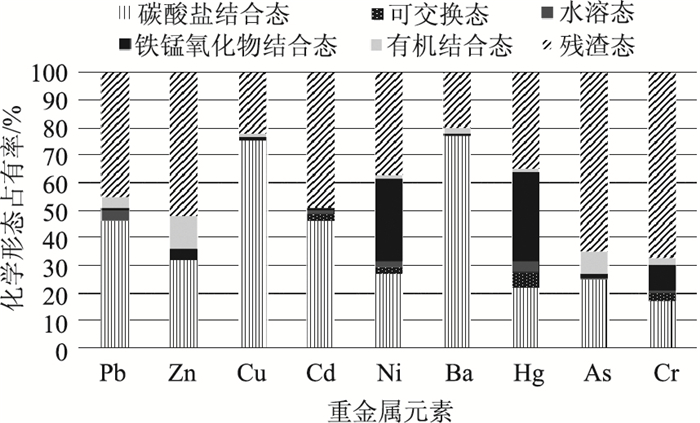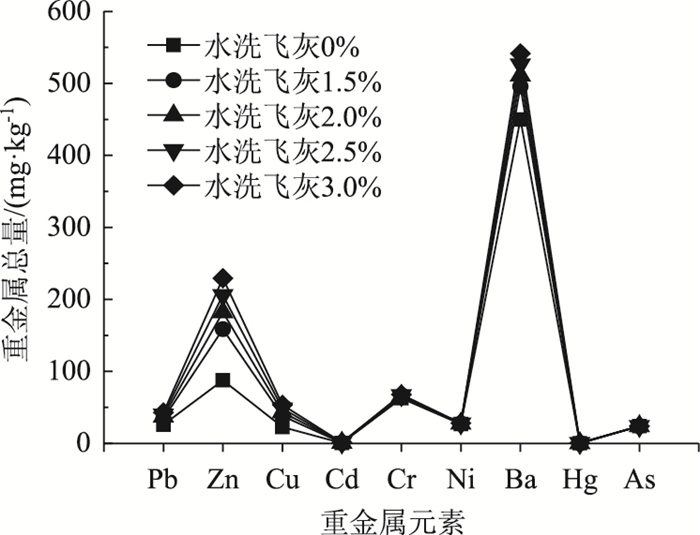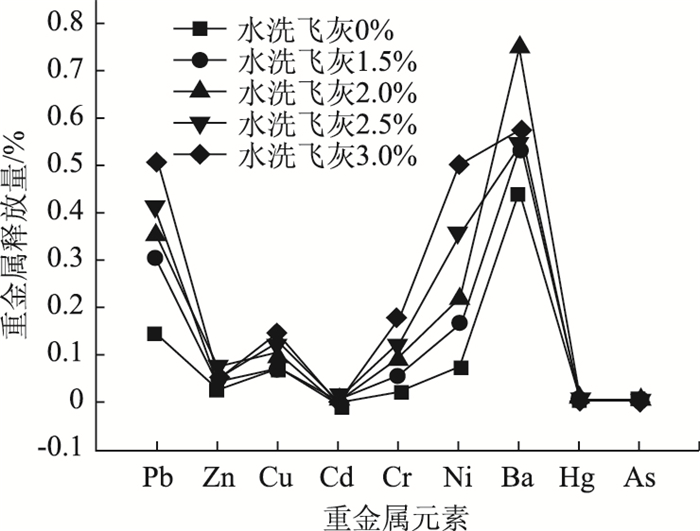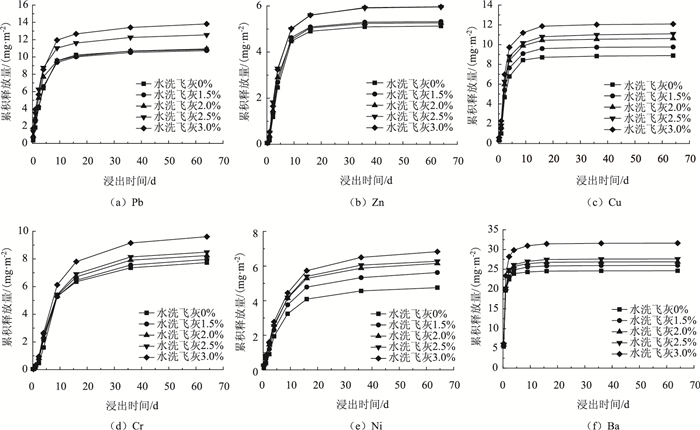扩展功能
文章信息
- 李达, 孔恒, 郭飞, 韩苗苗, 乔建刚
- LI Da, KONG Heng, GUO Fei, HAN Miao-miao, QIAO Jian-gang
- 垃圾焚烧水洗飞灰沥青混合料重金属浸出机理研究
- Study on Extraction Mechanism of Heavy Metal in Waste Incineration Washed Fly Ash Asphalt Mixture
- 公路交通科技, 2018, 35(8): 13-18
- Journal of Highway and Transportation Research and Denelopment, 2018, 35(8): 13-18
- 10.3969/j.issn.1002-0268.2018.08.003
-
文章历史
- 收稿日期: 2018-05-07
2. 北京市道路工程质量监督站, 北京 100076;
3. 北京市政建设集团有限责任公司, 北京 100048;
4. 河北工业大学 天津交通工程绿色材料技术中心, 天津 300401
2. Beijing Road Engineering Quality Supervision Station, Beijing 100076, China;
3. Beijing Municipal Construction Group Co., Ltd., Beijing 100048, China;
4. Hebei University of Technology, Tianjin Traffic Engineering Green Materials Technology Center, Tianjin 300401, China
随着城镇化进程的加快,城市垃圾数量不断增加,焚烧是处理城市垃圾最有效的方法之一,但是焚烧垃圾会产生大量含Hg,Pb,Cr,Cd,Mn,Zn等重金属的飞灰,严重危害着生态环境[1-3]。目前飞灰道路资源化的主要研究成果有:Hossam等[4]通过分析飞灰替代沥青混合料中的骨料,认为不同掺量的飞灰可用于沥青道路面层。纪涛等[5]发现巯基捕收剂对Cu,Pb,Cd,Cr,Zn和Ni这6种重金属的总稳定化率均超过70%。潘赟等[6-7]研究发现水洗预处理飞灰中部分重金属Zn和Cd达标,Pb依然超标。谭巍等[8-10]研究发现掺入飞灰的沥青混合料的水稳定性大幅降低。陈林[11]得出飞灰添加比例和重金属的溶出量成正比关系。目前针对飞灰中重金属的稳定固化和飞灰在沥青混合料中的组分研究较多[12-16],但对重金属浸出毒性的程度分析较少,所以分析重金属的浸出机理,对保护生态环境实现飞灰资源化利用非常必要。
1 试验设计飞灰中Pb,Zn,Cu,Cd,Cr,Ni,Ba,Hg,As等重金属用在沥青路面内会对道路周围的土壤和水体产生污染,为此设计含量0%,1.5%,2.0%,2.5%,3.0%的水洗飞灰沥青混合料重金属浸出试验,探索飞灰对沥青道路的环境影响程度。
1.1 试验方法《固体废物浸出毒性浸出方法硫酸硝酸法》(HJ/T299—2007)[17]是测定固体废弃物中重金属等污染物浸出量的常用方法。将水洗飞灰沥青混合料破碎成粒径小于9.5 mm的颗粒,调节转速为(30±2)r/min的翻转式振荡装置于(23±2)℃下振荡(18±2)h,收集浸出液冷藏待分析测试。
水槽浸出试验(EA NEN7375)[18]是测定块状固体废物材料中污染物浸出量和浸出机理的常用方法。将车辙板试件切割成5 cm×5 cm×1 cm的立方体试件,在酸雨条件下测定其中的重金属有效释放量。
同时将水洗飞灰沥青混合料经过破碎、研磨、过筛,选取合适粒径进行重金属总量和有效量释放试验,用电感耦合等离子体质谱仪(ICP-MS)测定浸出液中各元素浓度。将样品研磨成粒径D≤125 μm,采用王水和HF对样品进行消解试验,测定不同试验方案水洗飞灰沥青混合料试件的重金属浸出量。
1.2 试验参数选择水洗飞灰沥青路面直接暴露于外界环境中,其重金属易受到自然降雨的影响而浸出。影响重金属浸出的因素有降雨pH值、降雨量、浸出时间及重金属释放速率等。
(1) 试验pH值:我国酸雨类型主要为硫酸型,少量为硝酸雨,主要酸根离子包括SO42-和NO3-。硫酸根离子占总阴离子的70%~90%。根据硫酸硝酸法和水槽浸出试验规范要求,采用质量比为2:1的浓H2SO4和浓HNO3混合液模拟pH值为3.2的酸雨。
(2) 试验液固比:试验液固比是指浸取液体积与水洗飞灰沥青混凝土的质量之比。自然降雨下沥青路面在使用过程中将会有一定量的雨水渗入土壤,由此得到试验年入渗雨量Q的计算公式如下。

|
(1) |
式中,Q为模拟年入渗雨量;P为全国酸雨区年均最大降水量,取值2 800 mm;Λ为沥青路面入渗系数,取值0.05;A为沥青混凝土试样表面积,取值70 cm2(长5 cm×宽5 cm×高1 cm的立方体);30为1 mm降雨量时量雨器所盛雨水的体积;314为量雨器的底面积值。常用的AC-20C飞灰沥青混凝土的密度一般为2.40 g/cm3,其试样质量平均为60 g,计算得到液固比为15.6 mL/g。
(3) 浸出时间:结合规范得到试验的浸出时间,如表 1所示。
| 阶段 | 浸取液更换时间 | |
| 累积时间/d | 时间间隔/h | |
| 1 | 0.25 | 6 |
| 2 | 1 | 18 |
| 3 | 2.25 | 30 |
| 4 | 4 | 42 |
| 5 | 9 | 120 |
| 6 | 16 | 168 |
| 7 | 36 | 480 |
| 8 | 64 | 672 |
2 水洗飞灰沥青混凝土的化学分布形态
由化学相关知识可知,重金属化学形态越不稳定、含量越多,受周围环境影响越大,重金属的释放风险就越大,所以水洗飞灰中重金属的浸出量与重金属的化学形态分布和含量紧密相关。水洗飞灰中重金属的分布形态有酸提取态、可还原态、可氧化态、残渣态等,其稳定性大小为酸提取态 <可还原态 <可氧化态 <残渣态。水洗飞灰中重金属形态的分布如图 1所示。

|
| 图 1 水洗飞灰重金属形态分布 Fig. 1 Distribution of heavy metals in washed fly ash |
| |
图 1表明,重金属的分布以稳定态形式存在的残渣态为主,以不稳定态形式存在的酸提取态次之,以稳定态形式存在的可还原态和可氧化态所占比例较少。在不稳定的酸提取态中,碳酸盐结合态为主要存在形式,可交换态和水溶态所占的比例很少,可以忽略不计。碳酸盐结合态中Cu和Ba所占的比例可达75%以上,Cd和Pb占比46%,Zn占比32%,Ni,Hg和As占比约为25%,Cr占比为17%。因此,水洗飞灰中的重金属易被浸出程度为Ba>Cu>Pb=Cd>Zn>Ni>As>Hg。
3 水洗飞灰沥青混凝土中重金属的浸出机理 3.1 重金属总量水洗飞灰沥青混凝土中重金属总量是衡量重金属浸出潜在风险的重要指标。通过ICP-MS试验仪器测定掺加不同比例的水洗飞灰沥青混合料试件浸出液,得到各金属元素总量结果,如图 2所示。

|
| 图 2 水洗飞灰沥青混凝土重金属总量 Fig. 2 Total amount of heavy metals in washed fly ash asphalt concrete |
| |
由图 2可知,水洗飞灰沥青混凝土中不同种类重金属的总量随着水洗飞灰掺量的增加而提高。浸出重金属总量排序为Ba>Zn>Cr>Cu>Pb>Ni>As>Cd>Hg,其中重金属Ba总量最大,平均值为504.86 mg/kg;Zn次之,平均值为172.63 mg/kg;Cr,Cu,Pb和As的平均值分别为65.62,41.08,36.09,23.92 mg/kg;Cd和Hg总量较少,分别为0.83 mg/kg和0.29 mg/kg。
3.2 重金属实际释放量为探究重金属的总量与浸出量之间的关系,采用硫酸硝酸法对水洗飞灰沥青混凝土试样测定其重金属释放量,结果如表 2所示。
| 项目 | Pb | Zn | Cu | Cd | Cr | Ni | Ba | Hg | As | |
| 《危险废物鉴别标准 浸出毒性鉴别》 | 3 000 | 50 000 | 50 000 | 300 | 10 000 | 10 000 | 100 000 | 50 | 1 500 | |
| 《生活饮用水卫生标准》 | 10 | 1 000 | 1 000 | 5 | 50 | 20 | 700 | 1 | 10 | |
| 水洗飞灰掺量/% | 0 | 3.72 | 2.15 | 1.57 | 0 | 1.37 | 1.91 | 200.34 | 0 | 0 |
| 1.5 | 10.35 | 6.82 | 2.63 | 0 | 3.46 | 4.41 | 262.83 | 0 | 0 | |
| 2.0 | 13.11 | 12.45 | 4.57 | 0 | 5.82 | 5.96 | 380.15 | 0 | 0 | |
| 2.5 | 16.28 | 9.56 | 5.94 | 0 | 8.38 | 9.72 | 285.81 | 0 | 0 | |
| 3.0 | 21.73 | 13.29 | 7.44 | 0 | 11.62 | 13.85 | 311.50 | 0 | 0 | |
由表 2可知,水洗飞灰沥青混凝土所有重金属浸出浓度符合《危险废物鉴别标准浸出毒性鉴别》(GB5085.3—2007)[19]的要求;Cu,Cd,Cr,Ni,Ba,Hg,As满足《生活饮用水卫生标准》 (GB 5749—2006)[20]要求;Pb和Zn的某些试验点不满足生活饮用水卫生标准,且水洗飞灰掺量为2.0%;Pb和Zn的浸出质量浓度出现突变,是其他飞灰掺量工况下的17倍和193倍。
通过计算水洗飞灰沥青混凝土中各重金属的实际释放量,得到飞灰沥青混凝土中重金属实际释放量与总量之比,如图 3所示。

|
| 图 3 水洗飞灰沥青混凝土中重金属实际释放量与总量之比 Fig. 3 Ratio of actual emission to total amount of heavy metals in washed fly ash asphalt concrete |
| |
由图 3可知,飞灰沥青混凝土中的重金属Pb,Zn,Cu,Cr,Ni和Ba均有一定的浸出,且随着飞灰掺量的增加,重金属浸出量整体呈现增长趋势,但增长幅度较小;当飞灰掺量分别为0%,1.5%,2.0%,2.5%,3.0%时,重金属Ba释放率最大,平均为0.523%;其次为Pb,平均值为0.340%;Ni的释放率平均值为0.271%;Cu,Cr和Zn的释放率平均值分别为0.100%,0.093%,0.043%;Cd,Hg和As在不同飞灰掺量下均没有发生浸出;重金属元素实际浸出率大小排序为Ba>Pb>Ni>Cu>Cr>Cd。
3.3 重金属的累积释放量通过分析不同水洗飞灰掺量下重金属累计释放量与浸出时间的相互关系,得到飞灰沥青路面中重金属的释放时域图,如图 4所示。

|
| 图 4 水洗飞灰沥青混合料中重金属累积释放时域图 Fig. 4 Time-domain curves of cumulative release of heavy metals in washed fly ash asphalt mixture |
| |
由图 4可知,水洗飞灰沥青混凝土中的重金属浸出量随着时间的增加而变大,且水洗飞灰掺量越多,各重金属累积释放量越大。但不同水洗飞灰掺量下,其沥青混凝土中重金属平均累积释放量的大小排序为Ba>Pb>Cu>Cr>Ni>Zn。Pb的累积释放量随着水洗飞灰掺量的增加而增大,但变化幅度较小,累积释放量曲线随着浸出时间呈逐渐上升趋势,在第8天左右累积释放量曲线均达到平衡,平均最大累积释放量约为11.78 mg/m2;Zn的累积释放量随着水洗飞灰掺量的增加整体呈增加趋势,且在前16 d时间内都有一个逐渐上升后趋于平衡的趋势,平均累积释放量为5.53 mg/m2;Cu的累积释放量随着水洗飞灰掺量的增加而增大,在第16天左右累积释放量达到平衡,平均累积释放量为10.49 mg/m2;Cr和Ni的累积释放量随着时间逐渐增长,达到平衡所需的时间较长,约为36 d,释放速率较低,平均累积释放量分别为8.41 mg/m2和5.93 mg/m2;Ba的平均累积释放量最大,约为27.35 mg/m2,达到平衡所需时间较短,为4 d左右,累积释放速率较快。
3.4 重金属的释放速率判别常见污染物释放速率通常采用释放系数的负对数PDobs来表征,其计算方法如下:

|
(2) |

|
(3) |
式中, Diobs为重金属在浸出阶段i的释放系数;Mi为重金属在浸出阶段i的浸出量;ρ为沥青混凝土试块样品密度;C0为重金属累积释放总量;ti为浸出阶段i结束时的时间;ti-1为浸出阶段i-1结束时的时间。
通过计算水洗飞灰沥青混合料中重金属的释放系数,得到PDobs与重金属Pb,Zn,Cu,Cr,Ni,Ba的释放速率关系,如表 3所示。
| 类型 | 水洗飞灰含量 | 释放速率判别 | ||||
| 0% | 1.5% | 2.0% | 2.5% | 3.0% | ||
| Pb | 23.43 | 23.37 | 23.21 | 23.19 | 23.34 | 低释放速率 |
| Zn | 23.68 | 23.64 | 23.57 | 23.57 | 23.59 | 低释放速率 |
| Cu | 23.11 | 23.07 | 23.05 | 23.05 | 23.02 | 低释放速率 |
| Cr | 24.28 | 24.23 | 24.21 | 24.21 | 24.24 | 低释放速率 |
| Ni | 23.95 | 23.94 | 23.89 | 23.92 | 23.94 | 低释放速率 |
| Ba | 22.37 | 22.41 | 22.4 | 22.43 | 22.43 | 低释放速率 |
根据表 3可知,水洗飞灰沥青混凝土中的重金属Pb,Zn,Cu,Cr,Ni和Ba的释放系数PDobs均大于12.5,根据PDobs>12.5为低释放速率的判定标准值,Pb,Zn,Cu,Cr,Ni和Ba的释放速率都是低迁移率,释放速率大小顺序为Cr>Ni>Zn>Ba>Pb>Cu。
4 结论为了达到焚烧垃圾飞灰资源化的目的,探究飞灰沥青路面对环境影响,采用电感耦合等离子体质谱仪等检测法,检测了不同飞灰掺量下的水洗飞灰沥青混合料重金属浸出总量、实际释放量。通过分析飞灰重金属形态分布占有率,得到水洗飞灰沥青路面中重金属浸出率大小排序为Ba>Pb>Ni>Cu>Cr>Zn。通过分析不同飞灰掺量下不同重金属浸出量与时间的相互关系,得到了不同飞灰掺量下主要重金属的释放时域图,进而解析出Zn,Cr,Cu,Pb,Ni,Cd,As等重金属浸出的演化机理,并通过重金属的释放速率判别得到重金属Pb,Zn,Cu,Cr,Ni和Ba的释放速率。在满足道路环境要求的同时,为实现飞灰的资源化利用提出了一种新研究思路。
| [1] |
BRATTEBO B O, BOOTH D B. Long-term Stormwater Quantity and Quality Performance of Permeable Pavement Systems[J]. Water Research, 2003, 37(18): 4369-4376. |
| [2] |
蒋建国, 许鑫, 张妍. 城市垃圾焚烧飞灰的硅酸盐水泥稳定化效果研究[J]. 环境科学, 2006, 27(12): 2564-2569. JIANG Jian-guo, XU Xin, ZHANG Yan. Investigation of Leaching Characteristics of Heavy Metals during Cement Stabilization of Fly Ash from Municipal Solid Waste Incinerator[J]. Environmental Science, 2006, 27(12): 2564-2569. |
| [3] |
张若冰. 垃圾焚烧过程中典型重金属污染物的分布特性研究[D]. 杭州: 浙江大学, 2002. ZHANG Ruo-bing. Study on Distribution Characteristics of Typical Heavy Metal Pollutants in Waste Incineration Process[D]. Hangzhou: Zhejiang University, 2002. http://cdmd.cnki.com.cn/Article/CDMD-10335-2002070176.htm |
| [4] |
HASSAN H F. Recycling of Municipal Solid Waste Incinerator Ash in Hot-mix Asphalt Concrete[J]. Construction & Building Materials, 2005, 19(2): 91-98. |
| [5] |
纪涛. 垃圾焚烧飞灰微波解毒与药剂稳定化及资源化技术研发[D]. 天津: 天津大学, 2010. JI Tao. Development of Technology for Safe Treatment of MSWI Fly Ash: Combination of Microwave Detoxification, Chemical Stabilization, and Resource Utilization[D]. Tianjin: Tianjin University, 2010. http://cdmd.cnki.com.cn/Article/CDMD-10056-1011263766.htm |
| [6] |
潘赟. 我国生活垃圾焚烧飞灰毒性行为及其资源化利用过程的风险评估[D]. 上海: 上海大学, 2015. PAN Yun. Toxicity Behavior of MSWI Fly Ash and Assessment of Its Recycling Risk in China[D]. Shanghai: Shanghai University, 2015. http://cdmd.cnki.com.cn/Article/CDMD-10280-1015991153.htm |
| [7] |
SALVADOR R, CASAL B, YATES M, et a1. Microwave Decomposition of A Chlorinated Pesticides(Lindane)Supported on Modified Sepiolites[J]. Applied Clay Science, 2000, 22(3): 103-113. |
| [8] |
谭巍, 李菁若, 季炜, 等. 城市生活垃圾焚烧飞灰在沥青混合料中的应用[J]. 中国公路学报, 2016, 29(4): 14-21. TAN Wei, LI Jing-ruo, JI Wei, et al. Application of Municipal Solid Waste Incinerator Fly Ash in Asphalt Mixture[J]. China Journal of Highway and Transport, 2016, 29(4): 14-21. |
| [9] |
李菁若, 谭巍. 城市生活垃圾焚烧飞灰对沥青混合料TSR的影响分析[J]. 中外公路, 2016, 36(1): 250-253. LI Jing-ruo, TAN Wei. Analysis of Influence of City Garbage Incineration Fly Ash on Asphalt Mixture TSR[J]. China Journal of Highway and Transport, 2016, 36(1): 250-253. |
| [10] |
李菁若, 谭巍, 张东长, 等. 城市生活垃圾焚烧飞灰/沥青胶浆的性能研究[J]. 公路交通科技, 2017, 34(11): 23-30. LI Jing-ruo, TAN Wei, ZHANG Dong-chang, et al. Study on Performance of Municipal Solid Waste Incinerator Fly Ash/Asphalt Mastic[J]. Journal of Highway and Transportation Research and Development, 2017, 34(11): 23-30. |
| [11] |
陈林.焚烧飞灰用于沥青路面中面层污染物溶出规律及风险评估[D].重庆:重庆交通大学, 2016. CHEN Lin. Incineration Fly Ash Used in Asphalt Pavement Surface Contaminants Dissolution Law and Risk Assessment[D]. Chongqing: Chongqing Jiaotong University, 2016. http://cdmd.cnki.com.cn/Article/CDMD-10618-1016163383.htm |
| [12] |
MARGALLO M, TADDEI M B M, HERNÁNDEZ-PELLÓN A, et al. Environmental Sustainability Assess-ment of the Management of Municipal Solid Waste Incineration Residues:A Review of the Current Situation[J]. Clean Technologies & Environmental Policy, 2015, 17(5): 1333-1353. |
| [13] |
TASNEEM K M, EUN J, NAM B H. Leaching Behaviour of Municipal Solid Waste Incineration Bottom Ash Mixed with Hot-mix Asphalt and Portland Cement Concrete Used as Road Construction Materials[J]. Road Materials & Pavement Design, 2017, 18(3): 687-712. |
| [14] |
KEULEN A, VAN Z A, HARPE P, et al. High Performance of Treated and Washed MSWI Bottom Ash Granulates as Natural Aggregate Replacement within Earth-moist Concrete[J]. Waste Management, 2016, 49: 83-95. |
| [15] |
PAVLÍK Z, KEPPERT M, PAVLÍKOVÁ M, et al. Environmental Friendly Concrete Production Using Municipal Solid Waste Incineration Materials[J]. WIT Transactions on Ecology and the Environment, 2011, 148: 325-334. |
| [16] |
段华波.危险废物浸出毒性鉴别理论和方法研究[D].北京:中国环境科学研究院, 2006. DUAN Hua-bo. Study on Identification Theory and Method for Extraction Toxicity of Hazardous Waste[D]. Beijing: Chinese Research Academy of Environmental Sciences, 2006. |
| [17] |
HJ/T299-2007, 固体废物浸出毒性浸出方法硫酸硝酸法[S]. HJ/T299-2007, Solid Waste-Extraction Procedure for Leaching Toxicity-Sulphuric Acid & Nitric Acid Method[S]. |
| [18] |
EA NEN7375: 2004, Leaching Characteristics of Moulded or Monolithic Building and Waste Materials-Determin-ation of Leaching of Inorganic Components with the Diffusion Test[S].
|
| [19] |
GB5085. 3-2007, 危险废物鉴别标准浸出毒性鉴别[S]. GB5085. 3-2007, Identification Standards for Hazardous Wastes-Identification for Extraction Toxicity[S]. |
| [20] |
GB 5749-2006, 生活饮用水卫生标准[S]. GB 5749-2006, Standards for Drinking Water Quality[S]. |
 2018, Vol. 35
2018, Vol. 35
